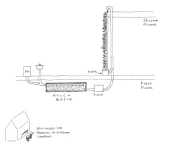
 1
1








I want to be 15 again …so I can ruin my life differently.
 2
2




I’d rather not have to spend $5-6k on a septic that we don’t really need
John Daley Bendigo, Australia The Enemy of progress is the hope of a perfect plan
Benefits of rainfall collection https://permies.com/t/88043/benefits-rainfall-collection
GOOD DEBT/ BAD DEBT https://permies.com/t/179218/mortgages-good-debt-bad-debt
 1
1




 2
2








dishwater if you are composting
John Daley Bendigo, Australia The Enemy of progress is the hope of a perfect plan
Benefits of rainfall collection https://permies.com/t/88043/benefits-rainfall-collection
GOOD DEBT/ BAD DEBT https://permies.com/t/179218/mortgages-good-debt-bad-debt




John C Daley wrote:I dont agree its contradictory.
dishwater if you are composting
This fact is the difference, if minimal food goes down the sink to the septic, the load on that septic is vastly reduced.
Septic tanks should be seen as 'settlement' tanks, where the solids [ food ] are captured and eventually pumped out before the tank is blocked.
 5
5








Mediterranean climate, hugel trenches, fabulous clay soil high in nutrients, self-watering containers with hugel layers, keyhole composting with low hugel raised beds, thick Back to Eden Wood chips mulch (distinguished from Bark chips), using as many native plants as possible....all drought tolerant.
 1
1




 1
1




Kadin Goldberg wrote:Thanks everyone.
I have since learned that there is a 55 gallon septic that some people are installing but after talking with the environmental health department it seems like this may not be legit.
I was told that you CAN install a 42+ gallon tank for dishwater if you are composting BUT As per the grey water rules you have to have enough space in your septic to handle grey water if it can’t be reused (as per the state). So, the rules are sort of contradictory. I was then told that a 1000 gallon septic is the smallest possible when I asked to clarify. Ah well.
Just thought I’d share if anyone was wondering.
 1
1




 4
4




 1
1




 1
1




Burton Sparks wrote:I wonder if you could get a flush compost toilet (aka vermifilter) approved.
So I will need to double check the regulations. I believe that the waste that is produced is considered a biosolid under EPA regulations and would require evidence that certain pathogens have been reduced. Biosolids are usually managed by our water group. Let me look into this over the next couple of days and I will get back to you.








 2
2




Kadin Goldberg wrote:Hi everyone!
I am in the process of purchasing some land in Cochise County to build a strawbale-ish home. I have been talking with various county officials but hoping to get more clarity from someone here!
I plan on collecting rain water (with the occasional water haul if necessary) and plan to use a composting toilet. I’ve learned recently that because Arizona classifies your dish water as black water you apparently still need a septic system installed on your property. I’m trying to figure out if there is any way around this or if there is some sort of tiny septic system that can be used for this purpose. I’d rather not have to spend $5-6k on a septic that we don’t really need. I’d like to reuse my shower and sink water by filtering and watering plants anyways.
Any help/guidance you can give me would be greatly appreciated!
Thanks,
Kadin








lala funstar wrote:Minimum size for composting toilet and black water septic system is 200 gallons,,this is form the horses mouth

|
this tiny ad cannot hear you because of the banana
6 Rocket Builds - 3d Plans - Free Heat Bundle
https://permies.com/t/193434/Rocket-Builds-Plans-Free-Heat
|



